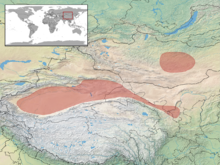
The Sinai agama is an agamid lizard found in arid areas of southeastern Libya, UAE, eastern Egypt, Israel, Jordan, Syria, Saudi Arabia, Oman, eastern Sudan, Ethiopia, Eritrea, and Djibouti.

The slowworm is a legless lizard native to western Eurasia. It is also called a deaf adder,slow worm, blindworm, or regionally, a long-cripple and hazelworm. The "blind" in blindworm refers to the lizard's small eyes, similar to a blindsnake.

The thorny devil, also known commonly as the mountain devil, thorny lizard, thorny dragon, and moloch, is a species of lizard in the family Agamidae. The species is endemic to Australia. It is the sole species in the genus Moloch. It grows up to 21 cm (8.3 in) in total length, with females generally larger than males.
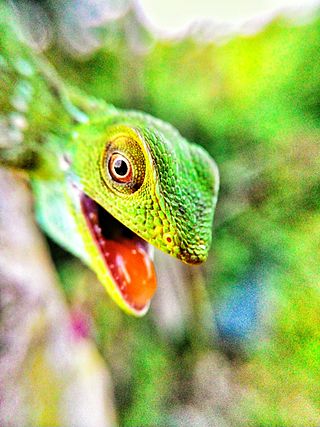
Bronchocela jubata, commonly known as the maned forest lizard, is a species of agamid lizard found mainly in Indonesia on the islands of Singkep, Java, Bali, Sulawesi, Karakelang, Salibabu; Nias Island, Singkap Island, Borneo (Kalimantan) also in Thailand, Cambodia and Philippines. Although in the past it was thought the species may be found in India, either on the mainland or in the Nicobars, this is not the case according to herpetologist Das. It is also known by the common name of "bloodsucker", although this is a misnomer.

Calotes calotes, the common green forest lizard, is an agamid lizard found in the forests of the Western Ghats and the Shevaroy Hills in India, and Sri Lanka.
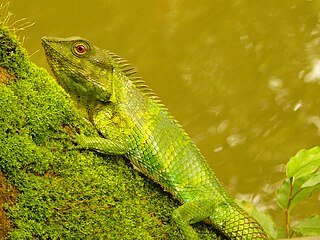
Calotes nemoricola, the Nilgiri forest lizard, is an agamid lizard found in the Western Ghats of India.
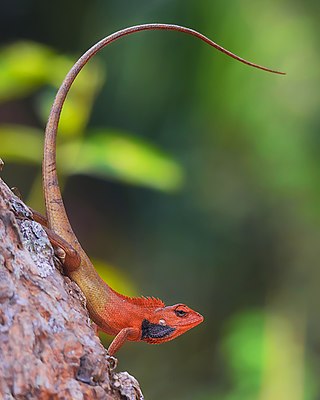
The oriental garden lizard, also called the eastern garden lizard, Indian garden lizard, common garden lizard, bloodsucker or changeable lizard, is an agamid lizard found widely distributed in Indo-Malaya. It has also been introduced in many other parts of the world.

The peninsular rock agama or South Indian rock agama is a common species of agama found on rocky hills in south India. An allied species, Psammophilus blanfordanus, is found in the Eastern Ghats, but north of the range of this species.

Salea horsfieldii, commonly known as Horsfield's spiny lizard or the Nilgiri salea, is a species of lizard in the family Agamidae. The species is endemic to the Nilgiri Hills of India.
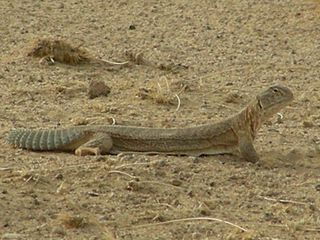
Saara hardwickii, commonly known as Hardwicke's spiny-tailed lizard or the Indian spiny-tailed lizard is a species of lizard in the family Agamidae. The species is found in patches across the Thar Desert, Kutch, and surrounding arid zones in India and Pakistan. It is mainly herbivorous and lives in numbers in some areas. Since it is found in loose clusters it often attracts predators such as raptors. It is also hunted by local peoples in the belief that the fat extracted from it is an aphrodisiac.

The Mexican alligator lizard, also known as the green arboreal alligator lizard, is an endangered species of lizard endemic to the Sierra Madre de Oaxaca highlands of Mexico. It can be found in the states of Puebla, Veracruz, and Oaxaca. It was originally described under the genus Gerrhonotus as Gerrhonotus gramineus by Edward D. Cope in 1864.

Chalcides bedriagai, commonly known as Bedriaga's skink, is a species of lizard in the family Scincidae. The species is endemic to the Iberian Peninsula. It usually lives in sandy areas with sparse vegetation and good ground cover. It can also live in open woodland and burrow into loose soil. Females of the species give birth to live young. This skink is active during day and dusk, and it is very timid. It may reach about 16 cm (6.3 in) in total length, and it has five digits on each foot. It preys on insects, spiders, slugs, and woodlice.

Lilford's wall lizard is a species of lizard in the family Lacertidae. The species is endemic to the Gymnesian Islands, the easternmost of the Balearic Islands, Spain.
Eryx somalicus, known commonly as the Somali sand boa, is a species of small snake in the Boidae family. As its scientific name and common name suggest, it is found in Somalia, but may also be present in eastern Ethiopia.

Phrynocephalus persicus, commonly known as the Persian toad-headed agama, is a small diurnal desert lizard of the family Agamidae. It is the westernmost representative of the Central Asian genus of toad-headed agamas Phrynocephalus and is only known from deserts and semideserts of Iran and possibly Azerbaijan.
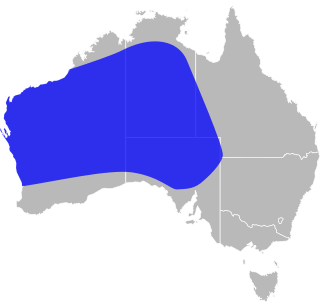
The hooded scaly-foot, also known as western scaly-foot, black-headed scaly-foot or western hooded scaly-foot, is an endemic Australian legless lizard of the family Pygopodidae.
Natalie's toad-headed agama is a species of agamid lizard endemic to the Zagros Mountains in Iran. The specific epithet honors Natalia Ananjeva of the Zoological Institute in St. Petersburg, Russia for her contribution to herpetological research of the family Agamidae and Phrynocephalus in particular.
Calotes bhutanensis is a species of lizard in the family Agamidae. It is endemic to the mountainous regions of Bhutan.

Teratoscincus roborowskii, commonly known as the Tibetan wonder gecko or Turpan wonder gecko, is a species of gecko in the family Sphaerodactylidae. The species is endemic to the Turpan Depression in Xinjiang, northwestern China, where it occurs in arid shrubland and desert habitats. It reaches a snout-vent length of 75.5–93.6 mm (3.0–3.7 in), and adult males tend to have wider heads than adult females.

Phrynocephalus vlangalii, also known as the Qinghai toad-headed agama, the Ching Hai toadhead agama, the Pylzow's toadhead agama, or gecko toadhead agama, is a species of viviparous agamid lizard endemic to the Tibetan Plateau in China. This lizard lives in burrows at high elevations of 2,000 to 4,600 meters. It is also known for its aggression, especially between females during mating season since females usually only have one mate. P. vlangalii curls its tail and shows a patch on its underbelly as defense displays against conspecifics. This lizard also has a variety of gut microbiota that help perform metabolic and biological functions depending on the altitude at which the lizard lives.

